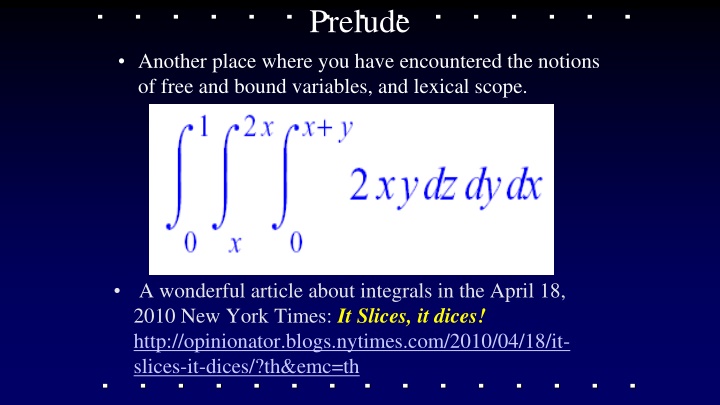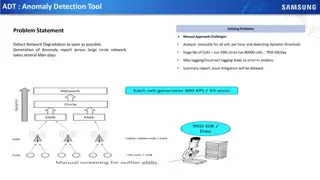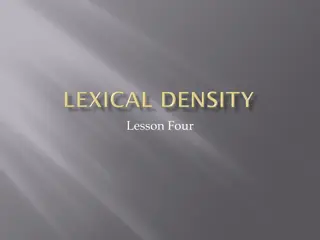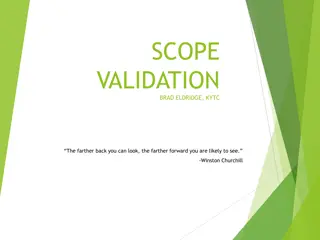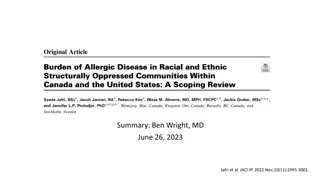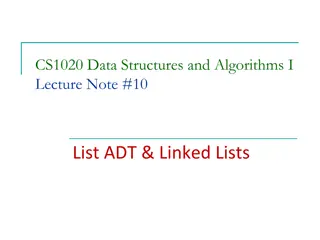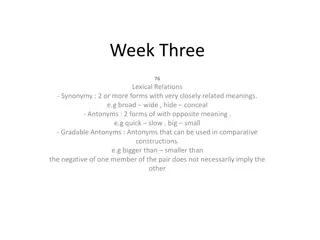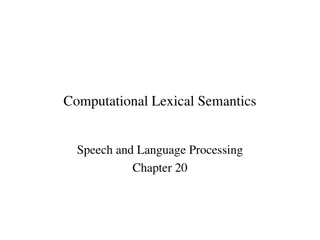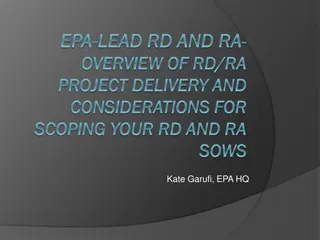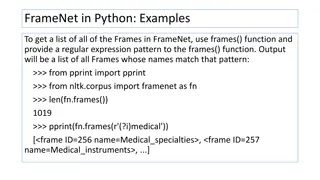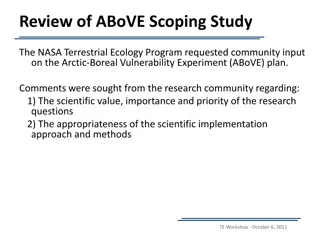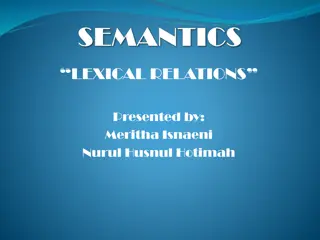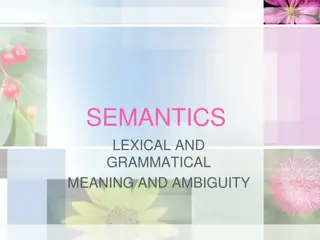Introduction to Environment ADT and Lexical Scoping
Delve into the concept of Environment Abstract Data Type (ADT) and lexical scoping as encountered in a wonderful article about integrals. Explore how environments map symbols to values, understand the principles of data abstraction and representation independence, and learn the implementation approaches. Witness the functionalities of constructors and observers in an environment ADT through examples featuring abstract E&C diagrams.
Download Presentation

Please find below an Image/Link to download the presentation.
The content on the website is provided AS IS for your information and personal use only. It may not be sold, licensed, or shared on other websites without obtaining consent from the author.If you encounter any issues during the download, it is possible that the publisher has removed the file from their server.
You are allowed to download the files provided on this website for personal or commercial use, subject to the condition that they are used lawfully. All files are the property of their respective owners.
The content on the website is provided AS IS for your information and personal use only. It may not be sold, licensed, or shared on other websites without obtaining consent from the author.
E N D
Presentation Transcript
Prelude Another place where you have encountered the notions of free and bound variables, and lexical scope. A wonderful article about integrals in the April 18, 2010 New York Times: It Slices, it dices! http://opinionator.blogs.nytimes.com/2010/04/18/it- slices-it-dices/?th&emc=th
CSSE 304 Day 19 Environment ADT Environment Representations Begin the Interpreter Project Intro
We now know how environments are supposed to behave. Next question: How can we implement them? ENVIRONMENTADT
Summary of EoPL Section 2.2 (details on the following slides) Principle from Section 2.1 Environment ADT Environment Interface Representation/Implementation Approaches
Principle from Section 2.1 Data abstraction leads to representation independence
Environment ADT An environment maps a finite set of symbols to a set of associated (Scheme) values Thus, an environment is a finite function Logically, an environment has the form { (s1, v1), (s2, v2), (sn, vn) } , where the si are all distinct. But we need some more details in order to get the lexical scoping effect.
Environment interface If f is an environment, and s, s1, , sk are all symbols, then (empty-env) (representation of the empty set) (apply-env f s) in the environment f) f(s) (get the value associated with s (all symbols si must be distinct, the vi may be any Scheme values) (extend-env '(s1 sk) '(v1 vk) f ) g where g(s) is vi if s=si for some i, 1 i k f(s) otherwise Recall that x means "the representation of the abstract object x" empty-env and extend-env are constructors; apply-env is an observer (getter)
Examples If f is an environment, and s, s1, , sk are all symbols, then Draw the abstract E&C diagrams to show what the above code is doing. (representation of the empty set) (empty-env) (apply-env f s) in the environment f) f(s) (get the value associated with s (all symbols si must be distinct, the vi may be any Scheme values) (extend-env '(s1 sk) '(v1 vk) f ) g where g(s) is vi if s=si for some i, 1 i k f(s) otherwise
Auxiliary procedure ; returns position of sym in los (or #f) (define list-find-position (lambda (sym los) (let loop ([los los] [pos 0]) (cond [(null? los) #f] [(eq? sym (car los)) pos] [else (loop (cdr los) (add1 pos))]))))
Representation 1 We first do an easy implementation, then aim for a more efficient one Take advantage of Scheme's first-class procedures Represent an environment by a procedure Each environment procedure takes a symbol as an argument This is straightforward Just translate the formal definitions into code We will do this same process later for other ADTs
(define empty-env (lambda () (lambda (sym) (eopl:error 'apply-env "No binding for ~s" sym)))) (define apply-env (lambda (env sym) (env sym))) (define extend-env (lambda (syms vals env) (lambda (sym) (let ([pos (list-find-position sym syms)]) (if (number? pos) (list-ref vals pos) (apply-env env sym))))))
Representation 2 Use data structures to represent environments. in particular, variant records created using define-datatype Note that the actual code for looking up symbols is the same as before, but now it is in apply-env.
Define the environment datatype (define-datatype environment environment? [empty-env-record] [extended-env-record (syms (list-of symbol?)) (vals (list-of scheme-value?)) (env environment?)]) How should scheme-value?be defined? (define scheme-value?
Define the environment datatype (define-datatype environment environment? [empty-env-record] [extended-env-record (syms (list-of symbol?)) (vals (list-of scheme-value?)) (env environment?)]) How should scheme-value? be defined? (define scheme-value? (lambda (v) #t))
Implementation 2 - the two constructors (define empty-env (lambda () (empty-env-record))) (define extend-env (lambda (syms vals env) (extended-env-record syms vals env)))
Implementation 2: The observer (accessor) procedure (define apply-env (lambda (env sym) (cases environment env [empty-env-record () (errorf 'apply-env "No binding for ~s" sym)] [extended-env-record (syms vals env) (let ([pos (list-find-position sym syms)]) (if (number? pos) (list-ref vals pos) (apply-env env sym)))]))) Comparisons of the two representations?
Representation 3 Represent environment as a list of lists <env-rep> ::= () ::= ((({<symbol>}*) ({<value>}*)) . <env-rep>) Three examples: (((a b) (3 4)) ((c) (2))) (((a b) (3 4)) ((c a x) (2 3 #f))) () (define apply-env (lambda (env sym) (if (null? env) (eopl:error 'apply-env "No binding for ~s" sym) (let ((syms (car (car env))) (vals (cadr (car env))) (env (cdr env))) (let ((pos (rib-find-position sym syms))) (if (number? pos) (list-ref vals pos) (apply-env env sym))))))) (define empty-env (lambda () '())) (define extend-env (lambda (syms vals env) (cons (list syms vals) env))) Sometimes called a "ribcage" structure (define rib-find-position list-find-position) *Code that is green will change in Representation 4 (a slight variation of Representation 3)
Representation 4 adds two improvements 1. Make each rib a single pair instead of a list saves space and lookup time 2. Replace the list of values in each rib by a vector of values So we can replace linear-time list-ref by constant-time vector-ref Rep 3 (((a b) (3 4)) ((c a x) (2 3 #f))) Rep 4 (((a b). #(3 4)) ((c a x). #(2 3 #f)))
Representation 4 Ribcage structure with these improvements
Implementing the ribcage (slide 1) (define empty-env (lambda () '())) (define extend-env (lambda (syms vals env) (cons (cons syms (list->vector vals)) env)))
Implementing the ribcage (slide 2) (define apply-env (lambda (env sym) (if (null? env) (error 'apply-env "No binding for ~s" sym) (let ((syms (car (car env))) (vals (cdr (car env))) (env (cdr env))) (let ([pos (rib-find-position sym syms)]) (if (number? pos) (vector-ref vals pos) (apply-env env sym)))))))
Compare with List of lists implementation (define apply-env (lambda (env sym) (if (null? env) (error 'apply-env "No binding for ~s" sym) (let ((syms (car (car env))) (vals (cadr (car env))) (env (cdr env))) (let ([pos (rib-find-position sym syms)]) (if (number? pos) (list-ref vals pos) (apply-env env sym)))))))
INTERPRETER PROJECT INTRODUCTION
Ready to write an interpreter! We have A parser that produces abstract expression trees error checking Environments implementations lexical-address A knowledge of how closures and environments work Soon we will also have CPS The rest is mostly details
Assignments weeks 6-10 Assignment Tentative due date Emphasis 13 (team) Day 22 primitive procedures, literals, lambda, let, if 14 (team) Day24 expand-syntax, cond, and, or, while etc. CPS, memoize, multi-value returns letrec, named let, while loop as syntax expansion define, set!, reference parameters CPS with data structure continuations, call/cc, advanced features Imperative form 15 (individual) Day 26 16 (team) Day 28 17 (team) Days 32 and 33 18 (team) Days 35 and 37 19 (individual) Day 39 Extra credit 150 points Demo it by 2:00 PM Wednesday of exam week TBA
Interpreter project Why do I have you write an interpreter? What is an interpreter? A mapping from __source code___ to _____meaning___ .
Major parts of an interpreter Front-end Analysis Lexical analysis (scanning) What are the pieces (tokens) of the program? Syntax analysis (parsing, lexical address) How do the pieces fit together (AST)? Type checking/coercion. (not in Scheme) Are the types of things consistent with their uses? Optimization of the code We will not discuss this much (Take CSSE 404) Evaluation This is the part that we will focus on You have already done most of the analysis (A10, A11). We will use the environment ADT.
Language Why is Scheme the implementation language? In CSSE 404, the source language? They do it differently in the EoPL book.
Load everything up! ; evaluator for simple expressions. Possible starting ; point for first interpreter assignment. In file main.ss ; ; ; Claude Anderson. Last modified January, 2020 (load "chez-init.ss") (define load-all ; make it easy to reload the files (lambda () ; when you are testing (load "datatypes.ss") (load "parse-procs.ss") (load "syntax-expand.ss") (load "env-procs.ss") (load "continuations.ss") (load "interpreter.ss"))) (load-all) Code is linked from the Schedule page. There is also a single-file version.
CSSE 304 Interpreter Read-eval-print (rep) loop: Print a prompt Read the next form (e.g., expression) to be evaluated. Parse the form to give an abstract syntax tree (AST). A11b Syntax-expand the AST to produce an AST that only has core forms. A14 Evaluate the expanded AST to produce a value. A13, A16, A17, A18 Print the value (if not void) and repeat all of these steps. Imperative form A19 Alternate interface for grading program: (eval-one-exp <exp>)
read-eval-print loop The main driver for the interactive interpreter. The major part that is left for you to write is top-level-eval (and the procedures that it calls). (define rep ; "read-eval-print" loop (lambda () (display "--> ") ; new prompt on purpose (let ([answer (top-level-eval ; this calls eval-exp (parse-expression (read)))]) (eopl:pretty-print answer) ; TODO: are there answers that ; should display differently? (rep)))) ; tail-recursive, stack doesn't grow
top-level-eval (define top-level-eval (lambda (parsed-form) (eval-exp parsed-form))) Later we'll add some syntactic forms that are not expressions; for example, (define var exp) eval-exp may not be sufficient for those forms, so we may need to add other cases to top-level-eval.
representing procedures (define-datatype proc-val proc-val? [prim-proc ; primitive procedure (name symbol?)]) ; Datatype for procedures. ; At first we have only one kind of procedure, ; but more kinds will be added later. ; The first kind that we will add: ; closures created by eevaluation of lambda
eval-exp how it works What it returns depends on the type of expression. If it s a literal expression If it s a variable reference If it s an application
eval-exp code ; eval-exp "is" the interpreter (define eval-exp (lambda (exp) (cases expression exp [lit-exp (datum) datum] [var-exp (id) ; look up its value. (apply-env init-env id)] [app-exp (rator rands) (let ([proc-value (eval-exp rator)] [args (eval-rands rands)]) (apply-proc proc-value args))] [else (eopl:error 'eval-exp "Bad abstract syntax: ~s" exp)])))
eval-rands and apply-proc (define eval-rands ; evaluate all of the args (lambda (rands) ; return a list of values (map eval-exp rands))) ; Apply a procedure to its arguments. ; At this point, only primitive procedures. ; User-defined procedures (closures) will be added later. (define apply-proc (lambda (proc-value args) (cases proc-val proc-value [prim-proc (op) (apply-prim-proc op args)] [else (eopl:error 'apply-proc "Attempt to apply bad procedure:" proc-value)])))
apply-prim-proc ; Usually an interpreter must define each built-in ; (primitive) procedure individually. (define apply-prim-proc (lambda (prim-proc args) (case prim-proc [(+) (+ (1st args) (2nd args))] ; better?: (apply + args) [(-) (- (1st args) (2nd args))] [(*) (* (1st args) (2nd args))] [(add1) (+ (1st args) 1)] [(sub1) (- (1st args) 1)] [(cons) (cons (1st args) (2nd args))] [(=) (= (1st args) (2nd args))] [else (eopl:error 'apply-prim-proc "Bad primitive procedure name:" prim-op)])))
build the initial environment (define *prim-proc-names* '(+ - * add1 sub1 cons =)) (define init-env; initial environment only (extend-env; contains primitive procedures. *prim-proc-names* ; Recall that an environment ; associates values (map prim-proc ; (not expressions) with variables. *prim-proc-names*) (empty-env)))
